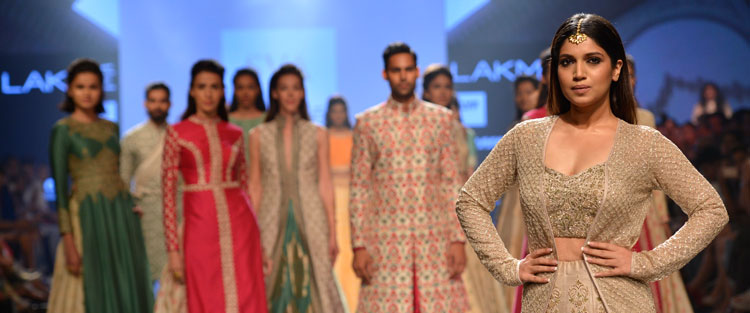
The business of couture
ICONIC FASHION DESIGNER Ralph Lauren had once said, “I don’t design clothes. I design dreams.” We spoke to a few top designers at the Lakme Fashion Week to discover how this motto finds resonance in their collections. In the bargain, we gathered insights into the creative minds of Marwari fashion designers, who are breaking stereotypes and treading paths that were hitherto unexplored.
 SVA
SVA
SVA, which means ‘soul’ in Sanskrit, celebrates designers Sonam and Paras Modi’s passion for heritage, colour and craftsmanship. Sonam’s expertise as a creative designer and Paras’ background in international business and their desire to start something together led to the birth of SVA. Paras and wife Sonam presented their collection ‘Mahal En Maroc’ at the LFW.
Inspired by the Hassan II Mosque in Casablanca, Morocco, Mahal En Maroc follows a romantic traveller’s heart with soft flowing silhouettes and dreamy drapes. The designs and motifs embellishing the historic tiles and minarets have been translated into prints, intricate embroideries and exquisite handwoven fabrics that breathtakingly merge history with fashion.
“Our work pays tribute to Indian hand weaving traditions and craft forms. We personally look into every aspect of the product, from manufacturing to finishing, fitting to displaying. We use intricate embroideries and unique colour combinations,” Sonam says.
The fabrics and prints are custom-made and are in sync with the season’s inspiration. What sets the brand apart from other bridal couture is the focus on minimalism. “Rich hand-woven fabrics and minimum embroidery add elegance to the overall look. We create ensembles that signify understated glamour,” Sonam adds.
Paras’ family hails from Sikar in Rajasthan and moved to Mumbai many years ago. His family is involved in the textile and fabric business for both local and international markets. “We visit Rajasthan together as a family every once in a while. We visit a few temples in and around our hometown and explore the local bazaars. I love the authentic Marwari cuisine there,” he says.
Talking about his childhood, Paras reveals, “My upbringing has been different compared to other Marwari children. My family always gave me the liberty to do things my way, and my ethics and philosophies are a reflection of that.” Marwaris are known to be excellent business people, and for Paras it was this background that enabled him to enter a creative field and carve a niche for himself and the brand.
 Lalit Dalmia
Lalit Dalmia
Lalit Dalmia is known for his intricate designs and glamorous ensembles that are evocative of India’s rich cultural heritage and often made of innovative materials such as thread mesh. He fuses different fabrics using advanced techniques such as neo-couture and precise laser technology. Lalit presented his collection ‘Unexplored Poised’ at the LFW.
The highlight of the collection was the unveiling of unexplored facets of embellishments, textures and details. Various textures such as fabric moulding, layering, applique, 3D floral and floating hemlines have been used. While the colour palette revolved around the hues of vivid blue, Helios tones, incense hues and wine tones and tints, multi-textured layers, asymmetrical hemlines, accentuated cuts, bodices and contemporary blazers celebrated
the contemporary, elegant art of the avant-garde.
“My dreams and fantasies are the inspiration behind this collection. It is my keen sense of imagination that sets me apart from my peers. I don’t think most can measure up to my level of wild creativity,” Lalit smiles.
Lalit’s family originally is from Chirawa, Rajasthan. They moved to New Delhi in 1975. Lalit, who makes sure to visit his hometown twice a month, feels Marwari values played a big role in his professional life, as they influenced his sense of designing. “My family has been typically traditional and conservative. I was the rebel who started to change things around and launched my own label in 2007 from New Delhi.” The family garment business was too boring and monotonous for his liking; he needed to give vent to his creativity and that’s why he decided to start his own label.
Lalit acknowledges that Marwaris are usually associated with entrepreneurship, and so it wasn’t too tough for him to carve a niche for himself in the designing world. “I was always a creative person. That, coupled with my Marwari instincts, helped me in my pursuit. I live to create art in whatever I do,” he concludes.
 Swati & Sunaina
Swati & Sunaina
It was in 2007 that Swati Agarwal and Sunaina Jalan came together to bring back the lost treasures of Indian woven textiles for discerning customers. Eight years later, in 2015, they created their eponymous brand offering bespoke pure zari saris and dupattas along with the finest of muslins, jamdanis and silks. Swati & Sunaina presented their collection ‘The Lightness of Being: Radha’ at the LFW.
Speaking about the inspiration behind the collection, Swati says, “Most people think handloom products are heavy and not fluid. We wanted to prove them wrong by presenting textiles that are fluid, sheer and comfortable for both weddings and casual wear.” Their design interpretation is derived from classic textiles of old Varanasi textile archives. The duo has produced weaving styles such as rang-kaat, cotton jamdani in single-ply 100 count cotton and pure gold tissue (a shimmering sheer textile).
While Swati is married to a Marwari family, with a family business—the Maithan Group—which manufactures steel and cement—Sunaina’s family is from Mukundgarh, Rajasthan. “I love authentic Marwari food, but our families left Rajasthan so long ago that we have assimilated different cultures along the way,” Sunaina says. Ruled by her heart rather than her mind, she feels being born and married to a Marwari family has helped her better her business sense. “My husband takes pride in my success and my two daughters have become my friends now. Family support is vital if women are to succeed in life,” Sunaina adds.
The products of the handloom industry today are concentrated on two ends of the spectrum: the ultra luxe, heavy silk-based saris; and the linen, cotton saris for everyday wear. What sets the brand apart is that it is right in the middle of this spectrum—an almost empty niche space. The biggest strength, feels the duo, is that the saris are easy to wear and yet have a luxurious look and feel.
Married to a Marwari family, Swati has come to understand and appreciate the intrinsic values of the community. “I learnt everything about saris from my mother-in-law. She has the most exquisite collection and her love for saris is so contagious. I continue to seek her approval when a new sari comes off the loom,” smiles Swati.
Swati & Sunaina is based on the ideology of reviving and supporting the centuries-old craftsmanship, and the handloom saris are made on the pit looms of Varanasi with techniques passed on for generations by master craftsmen. “What sets Marwaris apart is their risk-taking ability, and we are no different. When we started, even established houses thought this was an unprofitable segment. I am glad we chose the road less travelled,” Swati says.
Swati has no formal training in design or textile, and all her learning has been from the masters of the trade, the handloom weavers. “They have been amazing teachers, and we their keen students. There’s a lot of trust between us,” Swati says. It was Swati who made Sunaina realise her true potential. “I was a daughter, a wife and a mother, but never a designer. Swati brought out the best in me and our labour of love and hard work bore fruit,” Sunaina says with a smile.








